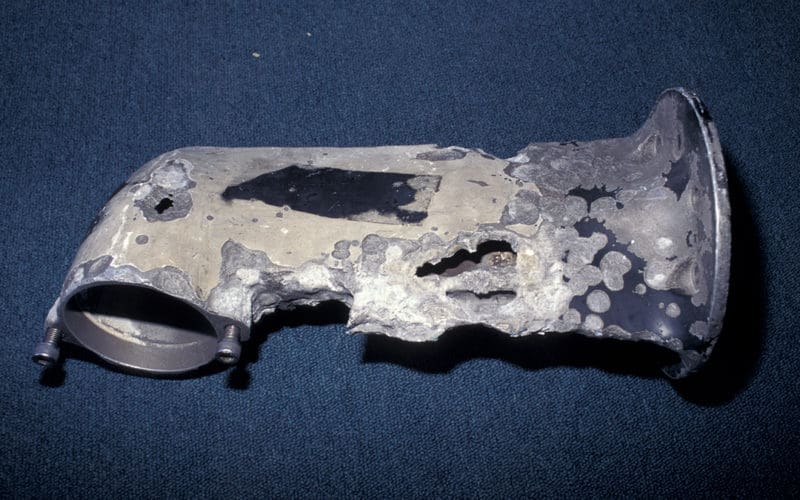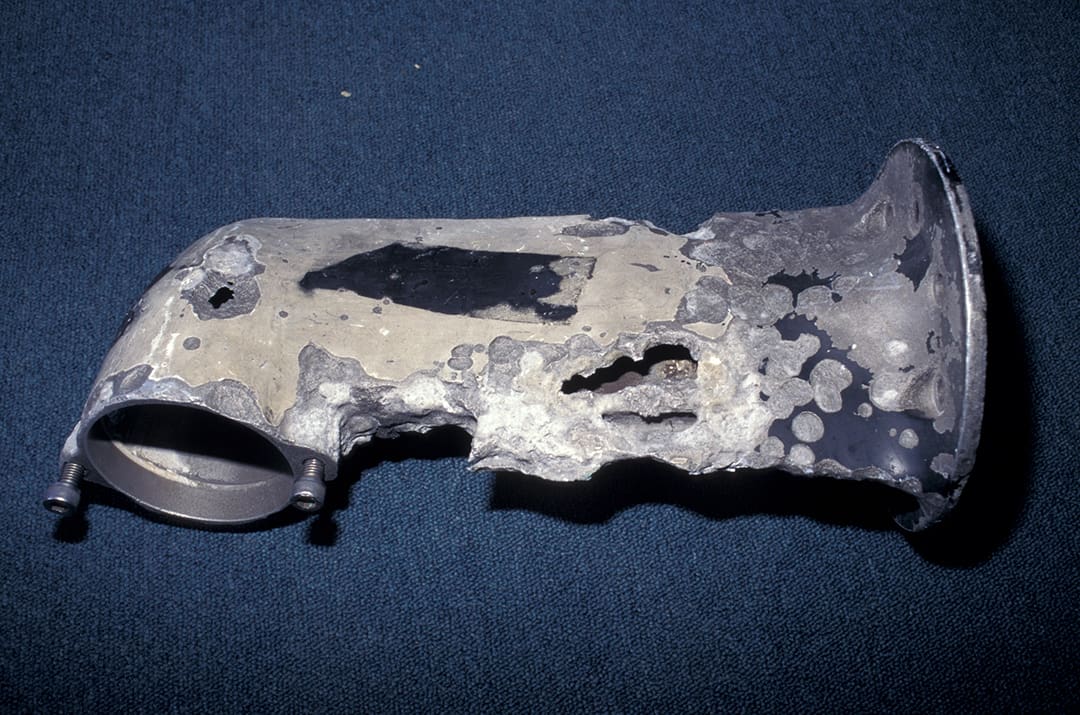
particularly insidious. It can occur very rapidly, in some cases over the course of weeks or even days.
“It’s the result of a bad ground!” How many times have you heard this when someone is evaluating a corrosion or electrical problem? But what exactly does that mean, why is it important and can it really be the cause of so many of these issues? In my experience, while it can be the source of a problem, this is a fallback phrase, used when folks really aren’t sure what the problem is or how to evaluate it.
If it’s corrosion related, then whoever is making this pronouncement should be able to draw a diagram representing the scenario, and that’s what I ask for: “Can you show me the path the electrons and ions are taking to make this possible?” Electrons travel through wire and metals, ions through water. If they reach for pencil and paper, that’s a good sign.
Having said all this, it’s not surprising that misunderstanding is the order of the day where bonding systems are concerned. Bonding systems (can) encompass guidelines from three American Boat and Yacht Council standards: E-2 Cathodic Protection, E-11 AC and DC Electrical Systems, and TE-4 Lightning Protection, which have different goals: corrosion mitigation, electrocution/fire prevention, and lightning strike mitigation, respectively. The various systems, DC negative, AC safety ground, and the bonding system, are typically, and in order to be ABYC compliant, connected as one (and even this interconnection is hotly debated in some technical circles). While the terms are used interchangeably, there are differences between grounding and bonding systems and their requirements and goals and, just to keep it interesting, there’s a considerable degree of overlap. For the sake of this discussion, however, I’ll stick to corrosion mitigation and use the term, bonding system, and all of the following applies to fiberglass composite hulls.
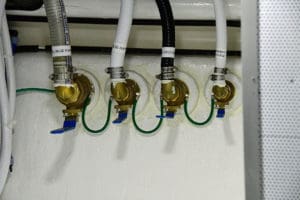
Design: what does a bonding system do?
In the simplest of terms, bonding systems are an interconnection of metallic components and, where corrosion issues are concerned, underwater metal components including through-hulls, struts, rudder stocks and propeller shafts, among others. In the latter case, while shafts are typically connected to transmissions — which are connected to engines, which in turn are connected to the DC negative bus, and thence to the bonding system — the oil in a transmission, which is an electrical insulator, can create a road block of sorts for the current traveling on bonding systems, leaving the propeller out of the loop. While not mandatory, it is for this reason that many propellers rely on shaft brushes to ensure a good, or better connection between shaft (and propeller) and bonding system. It’s worth noting, shaft anodes also solve this problem with less hassle, provided the configuration allows.
The average, under-$50 shaft brush is, while better than nothing, likely of little value when it comes to affording protection to the shaft and prop. The standard for cathodic protection, the protection provided by an anode (often called a “zinc” though it can also be made of aluminum or magnesium) to a cathode, a protected metal, is lofty indeed: No more than one ohm of resistance can exist between the two. Most inexpensive shaft brushes are simply unable to achieve this goal. Some boaters rely on multiple spring-loaded brushes and a silver slip ring arrangement, with a predictably higher cost.
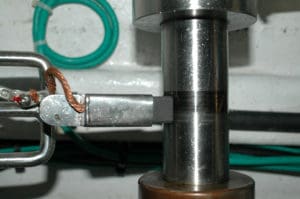
That’s the how, but what about the why of bonding? Interconnection of these underwater metals affords them valuable protection against stray current and galvanic corrosion. Stray current corrosion occurs when direct current (i.e., from a battery) “leaks” into water, typically bilge water, with the culprit often being faulty bilge pumps or their wiring. In seeking a return path to its source, it can be extremely destructive, it’s not unheard of for stray current to consume a propeller and shaft…in days. Think of it as electro-plating in reverse, electricity in this case removing metal. A bonding system provides an alternative, more direct path back to the power source, one that doesn’t travel through the water, thereby reducing, although not necessarily eliminating, the destructiveness of this type of corrosion. If that return path through the bonding system is direct enough, with low enough resistance, it will often trip the circuit breaker or blow the fuse for the fault’s power source, eliminating the stray current leak.
The other scenario in which the bonding system plays an important role is in the mitigation of galvanic or dissimilar corrosion. Galvanic corrosion occurs when dissimilar metals are in contact with each other, either directly or via wires, and immersed in an electrolyte, the same electrolyte (more on this below), or water, establishing a galvanic cell or battery. Once again, it’s reverse plating, albeit at a glacial pace. If stray current corrosion is the hare, galvanic corrosion is the tortoise, taking months and years to do its dirty work.
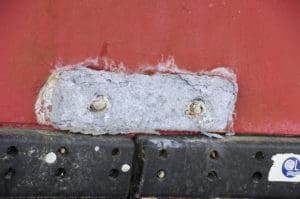
If dissimilar metals, when connected, are more likely to corrode, then why, you might ask, is it beneficial to connect them via a bonding system? There is one more important piece to the bonding system puzzle, the well-known but often misunderstood anode or zinc. When an anode (either zinc, aluminum or magnesium, depending on the type of water, salt, brackish or fresh, in which the vessel floats) is connected to the bonding system, it becomes the least noble metal in the electrical chain, and thus sacrifices itself. It’s an approach often referred to in the corrosion world as “bond and protect.” This is why anodes often include the prefix “sacrificial” as they protect the other interconnected metals (referred to in the corrosion argot as “cathodes”) by sacrificing themselves, until they are depleted, at which point the next least noble metal(s) will begin to corrode, protecting more noble metals in the group. Having said this, metal corrosion can still occur even if there is some anode left, a frequent occurrence with sterndrives. When the anode is depleted to the point where it’s unable to maintain the aluminum at a voltage more negative than its freely corroding potential, the aluminum will begin to corrode in spite of the presence of an anode. It is for this reason that anodes should be replaced when they are approximately 50 percent depleted. Trying to squeeze more life out of them than this is false economy.
While this interconnection method is proven and works well, it has limitations. One of the most misunderstood of these limitations is the distance over which an anode can provide protection. Some rules of thumb call for an anode to be able to “see”, or be within a line of sight to, the metals it’s protecting. While that’s not strictly true, a transom anode will almost certainly protect a propeller that’s just a couple of feet away, the closer the anode the better. Perhaps the best and most misunderstood case involves anodes found within the cooling systems of engines, generators and other heat exchangers. These anodes are sized and designed to protect only these components, they do not and cannot protect underwater metals and, more important, hull anodes do not and cannot protect gear filled with raw water within the vessel, i.e., protected metals must reside in the same “body of water” as the anode; the water inside a heat exchanger is a different body of water than that outside the hull.
Execution: making sure it works
In order for this electrochemical process to work properly, a few requirements must be met. The interconnection of the metals must be reliable and of low resistance, once again no more than one ohm can exist between the anode and any protected metal, when measured with the vessel hauled out. This often represents a tall order as bonding systems live a harsh life, near and often in bilge water; stories among marine electricians regarding the sorry state of bonding wires and terminals are legion in the industry. Therefore, the utmost care must be taken to ensure these systems remain in good working order. Wiring used to provide cathodic protection must be a minimum of AWG #8, and if the system doubles as lightning protection, that must be increased to AWG #6 (and larger for other conductors in that system). Of course, anodes must be installed so they remain connected to the bonding system every time they are installed.
Two of the most common bonding system faux pas include the use of tapping screws, and “daisy chaining.” Where ABYC compliance is sought, both of these practices are prohibited; tapping screws must not be used to complete connections as they cannot be sufficiently tightened and remain tight. Daisy chaining involves using the protected metal, a seacock for instance, as the path of current for other down-stream protected metals, i.e., two bonding wires are connected to this component, in different locations (connecting two bonding wires to a component, at the same screw or stud is acceptable). Each protected metal should be wired to a bonding bus or directly to an anode, without passing through other protected metals.
Like any other critical component, bonding systems should be inspected regularly. When installing or augmenting bonding systems, connections should be made using heat shrink terminals, and conductant paste such as Thomas and Betts Kopr Shield. Completed connections should be coated with corrosion inhibitor such as CRC Heavy Duty Corrosion Inhibitor. Tapping screws must never be relied upon to complete bonding systems, or any other electrical connections. When the vessel is hauled, a resistance test should be carried out to confirm no more than one ohm exists between bonded metals and the anode. n
Steve D’Antonio has managed boat yards and custom boat building shops and has written more than 1,000 articles. In 2007 Steve launched Steve D’Antonio Marine Consulting, Inc. (www.stevedmarineconsulting.com), offering marine systems consulting, management and technical training.

